The NFL’s Turf Problem: How Money Keeps Beating Player Safety
All NFL Games Should Be Played on Grass.
Players have said it for years, fans have said it for years, and the evidence continues to pile up. Artificial turf changes the way the game feels and the way it hurts.
Players don’t just fall — they get caught. Cleats stick, joints twist, and the result is often a season-ending injury that never needed to happen.
Every year the same pattern plays out. A major player goes down on turf, the league promises to “look into it,” and nothing changes.
The Real Power Behind the Fields
The NFL talks about player safety, but the problem runs deeper than that. This isn’t just about the league or the players — the real power lies with the people who own the stadiums.
Most NFL venues are owned by team owners or local governments, and their top priority isn’t player safety. It’s maximizing revenue.
Turf allows for concerts, college games, and events to fill the calendar year-round. Grass doesn’t.
Turf’s Convenience Beats Common Sense
Turf is cheaper to maintain, easier to replace, and far more convenient for venues trying to stay booked. From a financial perspective, it makes sense. From a player health standpoint, it doesn’t.
The most dangerous version of the surface has been slit-film turf — used in stadiums like Lucas Oil, MetLife, and the Superdome. It’s designed to last longer, but the narrow slits in each blade increase the risk of cleats getting trapped.
What the Data Says
Studies have shown that non-contact lower-body injuries occur significantly more often on turf than on natural grass. Between 2012 and 2018, turf caused 28 percent more total injuries, 32 percent more knee injuries, and a 69 percent higher chance of ankle or foot injuries.
These aren’t minor differences. They’re the kind of numbers that change careers.
Even with that data, the NFL has continued to lean on selective statistics, pointing out that a few grass fields produce more injuries than some turf fields. They’ll highlight one season where injury rates were nearly identical, while ignoring the larger trend that shows the opposite.
The Owners’ Reality
Even if the league wanted to mandate all-grass surfaces, it couldn’t. The NFL doesn’t control most stadiums.
Owners and local governments do, and they’re not willing to sacrifice concert and event revenue for the sake of softer landings on Sunday.
Ironically, those same stadiums were quick to promise natural grass when FIFA announced the 2026 World Cup. Every major NFL venue with turf volunteered to install grass because international soccer requires it. The money made the decision easy.
Following the Money
When it benefits them, they’ll do it. When it benefits their players, they won’t.
The argument that grass is too expensive doesn’t hold up either. Front Office Sports estimated that it would cost around $12 million total to switch every NFL field to grass — a fraction of one franchise’s annual revenue.
Even for indoor stadiums, maintenance would cost a few million more per year. But when there’s concert revenue at stake, the conversation stops cold.
The “Compromise”
Many teams are now replacing slit-film turf with a safer alternative called monofilament turf. It’s smoother, with fewer cleat lockups, and it costs about $1.2 million to install.
After this year, only one team — Cincinnati — will still use slit-film. It’s progress, but players say it still doesn’t feel right.
The surface is too hard, the cuts are too sharp, and the recovery is worse. It might be safer than before, but it’s not the same as playing on grass.
What It Would Take to Change
Former NFL executive Andrew Brandt summed it up best: owners don’t make changes because it’s right. They make changes when it’s profitable.
Until losing players becomes more expensive than losing concerts, nothing will change. The league won’t mandate it, because doing so would mean admitting they’ve ignored the issue for decades.
Eventually, the economics may shift. Player salaries are higher, franchise values keep climbing, and losing stars to turf injuries hurts everyone’s bottom line.
But until that happens, the NFL will keep playing on plastic grass. And players will keep paying the price for it.




